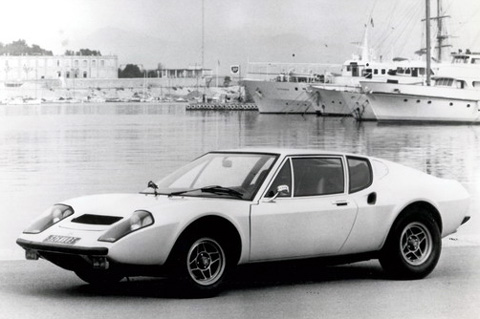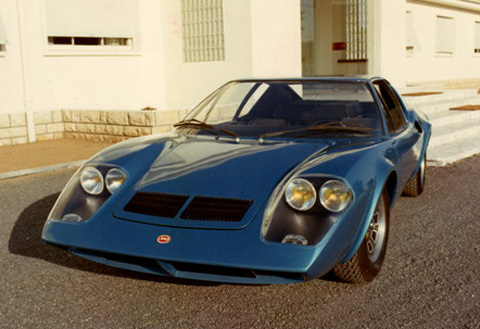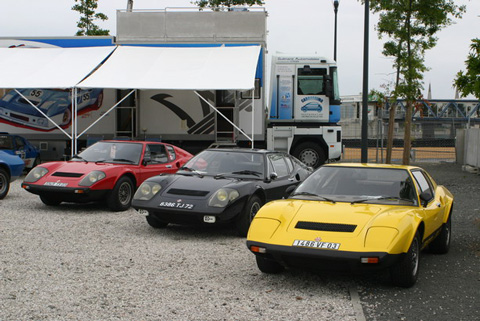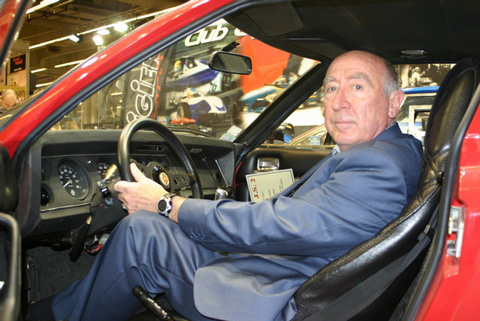
Ligier JS2 1973 fitted with the V6 Maserati.
By Thierry Lesparre
Translation by Francois de Pouqueville
The Ligier JS2 is just like Guy Ligier himself, you may like it or you may not, but in any case it won’t leave you indifferent.
Born on July 12, 1930, the young Guy Ligier began working as a butcher apprentice at age 14. An accomplished athlete, he excelled in all the sports he practiced, from rowing to rugby. In 1957, giving up his team sports career, he became a fairly successful competition motorcycle driver, even winning the French championship on his Norton 500cc. Wisely, he invested the purses gained in motorcycle racing in the purchase of his first hydraulic excavator which marked the departure point of the Ligier general contractor enterprise.
In 1960, he tried his luck in car racing at the wheel of an Elva, in Formula Junior. As his contracting business was rapidly expanding, and having had repetitive problems with Elva, Ligier decided to take a break from the racetracks. But that lull was short lived, and he soon got back behind the wheel, competing from time to time in rallies such as the Tour de Corse, and at Le Mans in 1964. The following year, joining the Ford France Team provided the occasion for the pilot from Vichy to unveil his talents as a multi talented racer. But, for Ligier, Formula 1 was already the optimal goal and in 1966, at age 36 and sponsored by BP, that he took part in his first Grand Prix. In 1966 and 1967, Guy competed in twelve Grand Prixs behind the wheel of a Cooper T81 with the Maserati engine, and then with a Brabham BT20. The following year, with José Behra, he founded the Inter Sport BP team, preparing two McLaren M4As, one for himself and the other for his good buddy Jo Schlesser.

Ligier Prototype pictured in front of Guy Ligier’s office. The Ligier company was and still is based on Abrest a small town near Vichy.
That same year, Honda offered to Schlesser the wheel of one of their F1 RA302 for the Grand Prix de France. Jo had an opportunity to race his first Grand Prix. Alas, after completing only 3 laps of the Rouen Les Essarts track, his Japanese Grand Prix car veered off course, flipped over and caught fire. Very distraught by the tragic death of his friend, Ligier considered leaving the competition circuit, but his passion for racing was stronger.
He decided that it was time for him to build his own car. He had a precise idea of what he wanted. It should not be too wide, with a good forward visibility, a low center of gravity, a powerful power plant and good flexibility. However, it should be comfortable, with rather high and wide doors to allow for an easy frequent daily access, the aim being to allow it to be commercialized later. Less than 18 months after Jo Schlesser’s fatal accident, Ligier rolled out the JS1 (named after Jo Schlesser, as a homage to his late friend) at the 1969 Paris Salon de l’Automobile, with a body designed by the Italian firm of Frua. After an illustrious 1970 racing season, the Ligier JS1 was retired to introduce a more sophisticated model.
The JS2 prototype was first unveiled to the public in October 1970 at the Paris Salon. The body design of this newest issue from the Abrest works was again signed by Pietro Frua. The JS2 was to be powered by a 165 HP fuel-injected 2600cc Ford V6. The power plant was not finalized though, and the rumor was that the final model might be powered by a Maserati V6. In either case, the JS2 would have a 5-gear synchronized Citroën SM gear- box. The price of the new Ligier was said to be 59,000 francs ($11,800), however no date for its commercialization was released.

Three generations of the Ligier JS2 on a event run by the Club Ligier at LeMans. Right to left, in yellow, the last version with retractable headlights; a first version (black color) equipped with the 2.7 liter Maserati V6, and another version using the Maserati engine from the Merak, in red.
Finally, the announcement which came down like a guillotine blade was that Ford, wanting to develop its own GT model, decided against supplying an engine to Ligier. Salvation was now logically for Guy Ligier to deal with Citroën, who was already supplying the SM gearbox, and could also supply the Maserati engine, as the Italian company was already controlled by Citroën. Consequently, Michel Têtu had to redesign the rear berth of the JS2 prototype to allow enough space for the 2670cc version of the Italian V6. Ligier being unsatisfied by Pietro Frua’s design, the body styling was submitted to Pichon-Parat’s retouching. The first Maserati-powered JS2 was publicly unveiled at the October 1971 Paris Salon. Its price was now 74,000 Francs($14,800), roughly 15,800 Francs ($3,160) more than the Citroën SM. In February 1973, the JS2 Ligier adopted the V6 of the Merak. It went from 2670cc to 2965cc, which resulted in a 25 HP increase from the original model and its price was now 74,500 Francs ($14,900). From April 1974, Ligier’s partnership with Citroën was reinforced. Guy Ligier could then rely on the Citroën dealership network for the distribution and servicing of his cars.

Michel Têtu, the engineer responsible for the JS2, sits in his personal Ligier JS2. He is also President of the Club Ligier JS2.
Following the first oil crisis, the economic environment was not favorable to the commercialization of sports cars. When Citroën transferred the assembly of its last SMs to Ligier, production of the JS2 was completely discontinued. Guy Ligier and Michel Beaujon (who is credited for the various advances on both the street and race car versions of the JS2 since the departure of Michel Têtu in June 1972) used this forced interruption to drastically modify the car. The ultimate version of the JS2, easily recognizable for its retractable headlights and its 5-nut wheels, was unveiled at the 1975 Geneva Salon. The selling price was 80,000 Francs ($16,000).
Only seven Ligier JS2 of the new generation were ever built, but Guy Ligier had another aim in mind. He turned the page on the JS2 for good, to involve himself completely in his new challenge: Formula 1.
Nothing of the JS2’s competion history at LeMans, with the Ford DFV and the Maserati engines?
Delightful sensitivity regarding the death of Jo Schlesser. His car was a Honda–RA302, I think. It was really neat: magnesium monocoque with the engine hung from a high spar in the back. I think it was Richie Ginther who’d tested the car and found it so undeveloped he told Honda not to take it anywhere until lots more work had been done. Honda showed up with it at the French Grand Prix with a driver who was more familiar with Cobras than single seaters. The car passed fuel through/alongside the rollbar so it caught fire immediately when it flipped. I have a framed drawing of the car and its technical features, possibly I got it from Road & Track. We met Jo at the Daytona 24-hour race; quite a nice guy. I even had a Ligier brochure until the moving company lost 7 boxes of automobilia moving me 10 miles across town.